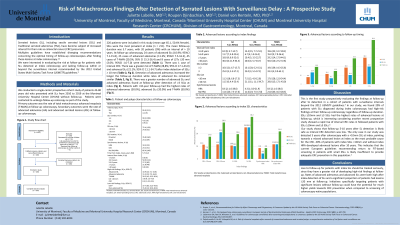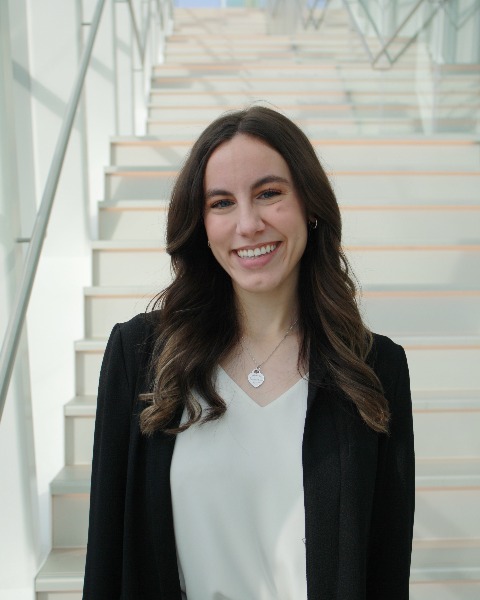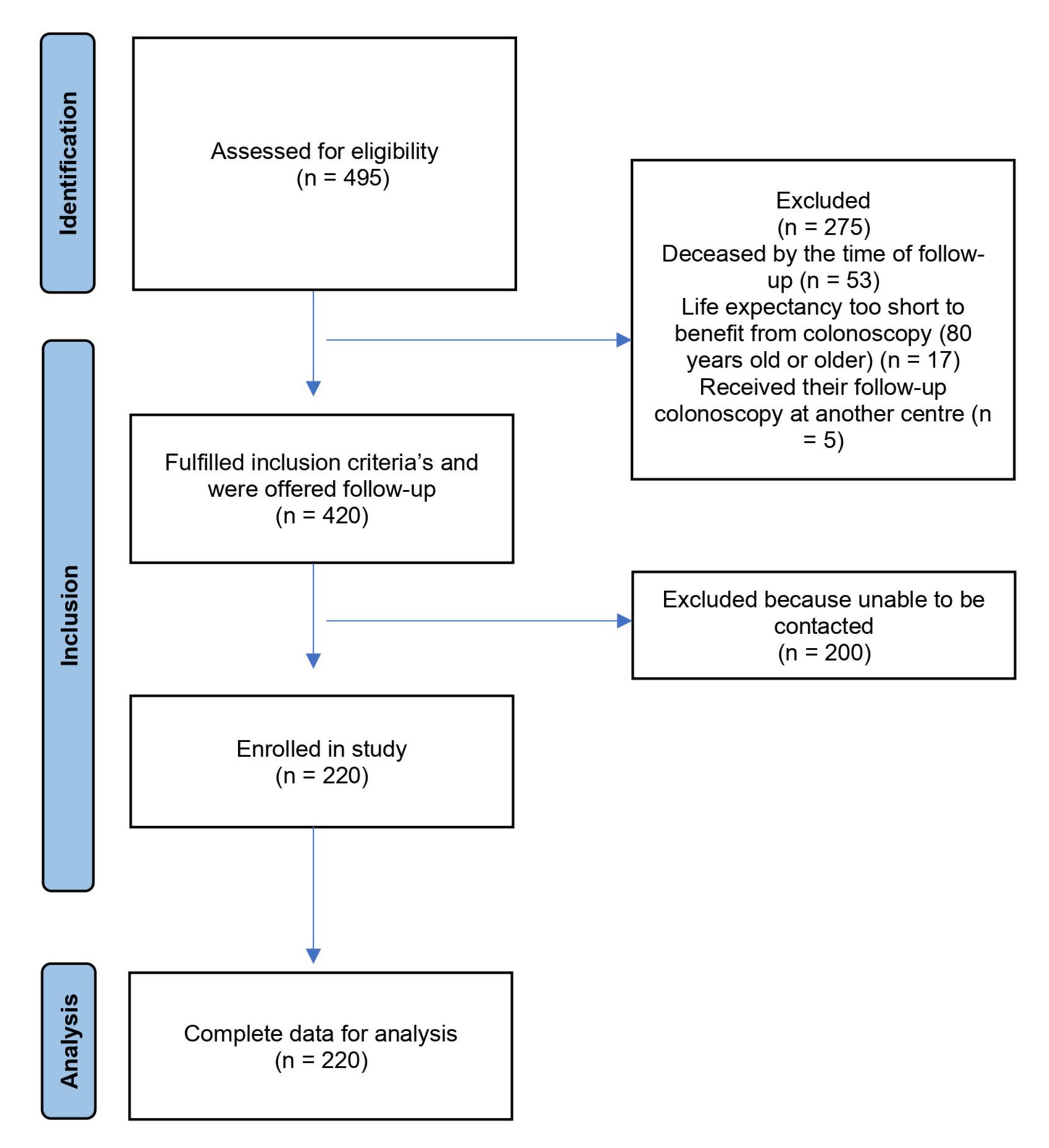Sunday Poster Session
Category: General Endoscopy
P0656 - Risk of Metachronous Findings After Detection of Serrated Lesions With Surveillance Delay: A Prospective Study
Sunday, October 27, 2024
3:30 PM - 7:00 PM ET
Location: Exhibit Hall E

Has Audio

Juliette Labelle, MD
Centre Hospitalier de l'Universite de Montreal
Montréal, QC, Canada
Presenting Author(s)
Juliette Labelle, MD, Roupen Djinbachian, MD, Daniel von Renteln, MD, PhD
Centre Hospitalier de l'Universite de Montreal, Montréal, PQ, Canada
Introduction: Serrated lesions (SL), including sessile serrated lesions (SSL) and traditional serrated adenomas (TSA), have become subject of increased interest for their role as colorectal cancer (CRC) precursors. Multiples guidelines have established diverging recommendations concerning the optimal timing of follow-up colonoscopies after finding these lesions at index colonoscopy. We were interested in evaluating the risk at follow-up for patients with SLs detected at index colonoscopy and lacking follow-up within or beyond the surveillance interval recommended by the 2012 United States Multi-Society Task Force (USMSTF) guidelines.
Methods: We conducted a single-center prospective cohort study of patients 45-80 years old who presented with SLs from 2010 to 2019 at the Montreal University Hospital Center (CHUM) without follow-up. Patients were contacted to undergo follow-up coloscopy as part of the study. Primary outcome was the rate of total metachronous advanced neoplasia (T-MAN) at follow-up. Secondary outcomes were the rate of advanced adenomas (AA) and advanced serrated lesions (ASL) at follow-up colonoscopy.
Results: 220 patients were included in this study (mean age 65.1, 50.4% female). Sessile serrated lesions were the most prevalent at index (n = 211, 95.9%). The mean follow-up duration was 5.7 years (SD: 2.2), with 20 patients (9%) with an interval of > 10 years. At follow-up colonoscopy, 45 cases of T-MAN were detected (20.5%; 95% CI 15.3-26.4), 8 cases of Laterally Spreading Tumours ≥ 20 mm (3.6%; 95% CI 1.6-7.0), 1 case of CRC (0.5%; 95% CI 0.0-2.5), 25 cases of advanced adenomas (11.3%; 95% CI 7.5-16.3), and 24 cases of advanced SLs (10.9%; 95% CI 7.1-15.8). There was a greater risk of T-MAN (28,8%; 95% CI 17.1-43.0) and advanced SLs (21.1%; 95% CI 11.1-34.7) after index detection of SSLs ≥ 10 mm.
Discussion: Patients with SLs at index have a greater risk of developing high-risk findings at follow-up. Rates of advanced adenomas and advanced SLs were both high after index detection of SLs and a significant proportion of patients had lesions ≥ 20 mm at follow-up.

Disclosures:
Juliette Labelle, MD, Roupen Djinbachian, MD, Daniel von Renteln, MD, PhD. P0656 - Risk of Metachronous Findings After Detection of Serrated Lesions With Surveillance Delay: A Prospective Study, ACG 2024 Annual Scientific Meeting Abstracts. Philadelphia, PA: American College of Gastroenterology.
Centre Hospitalier de l'Universite de Montreal, Montréal, PQ, Canada
Introduction: Serrated lesions (SL), including sessile serrated lesions (SSL) and traditional serrated adenomas (TSA), have become subject of increased interest for their role as colorectal cancer (CRC) precursors. Multiples guidelines have established diverging recommendations concerning the optimal timing of follow-up colonoscopies after finding these lesions at index colonoscopy. We were interested in evaluating the risk at follow-up for patients with SLs detected at index colonoscopy and lacking follow-up within or beyond the surveillance interval recommended by the 2012 United States Multi-Society Task Force (USMSTF) guidelines.
Methods: We conducted a single-center prospective cohort study of patients 45-80 years old who presented with SLs from 2010 to 2019 at the Montreal University Hospital Center (CHUM) without follow-up. Patients were contacted to undergo follow-up coloscopy as part of the study. Primary outcome was the rate of total metachronous advanced neoplasia (T-MAN) at follow-up. Secondary outcomes were the rate of advanced adenomas (AA) and advanced serrated lesions (ASL) at follow-up colonoscopy.
Results: 220 patients were included in this study (mean age 65.1, 50.4% female). Sessile serrated lesions were the most prevalent at index (n = 211, 95.9%). The mean follow-up duration was 5.7 years (SD: 2.2), with 20 patients (9%) with an interval of > 10 years. At follow-up colonoscopy, 45 cases of T-MAN were detected (20.5%; 95% CI 15.3-26.4), 8 cases of Laterally Spreading Tumours ≥ 20 mm (3.6%; 95% CI 1.6-7.0), 1 case of CRC (0.5%; 95% CI 0.0-2.5), 25 cases of advanced adenomas (11.3%; 95% CI 7.5-16.3), and 24 cases of advanced SLs (10.9%; 95% CI 7.1-15.8). There was a greater risk of T-MAN (28,8%; 95% CI 17.1-43.0) and advanced SLs (21.1%; 95% CI 11.1-34.7) after index detection of SSLs ≥ 10 mm.
Discussion: Patients with SLs at index have a greater risk of developing high-risk findings at follow-up. Rates of advanced adenomas and advanced SLs were both high after index detection of SLs and a significant proportion of patients had lesions ≥ 20 mm at follow-up.

Figure: Study Flow Chart
Disclosures:
Juliette Labelle indicated no relevant financial relationships.
Roupen Djinbachian: Fujifilm – Speakers Bureau.
Daniel von Renteln: Boston Scientific Inc. – Consultant. ERBE Elecktromedizin GmbH – Consultant, Grant/Research Support. Fujifilm – Grant/Research Support. Pendopharm – Consultant, Grant/Research Support. Pentax – Grant/Research Support. Ventage – Grant/Research Support.
Juliette Labelle, MD, Roupen Djinbachian, MD, Daniel von Renteln, MD, PhD. P0656 - Risk of Metachronous Findings After Detection of Serrated Lesions With Surveillance Delay: A Prospective Study, ACG 2024 Annual Scientific Meeting Abstracts. Philadelphia, PA: American College of Gastroenterology.
